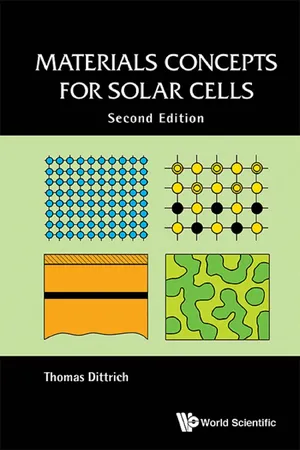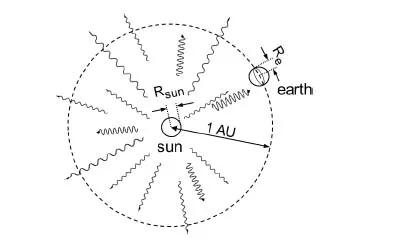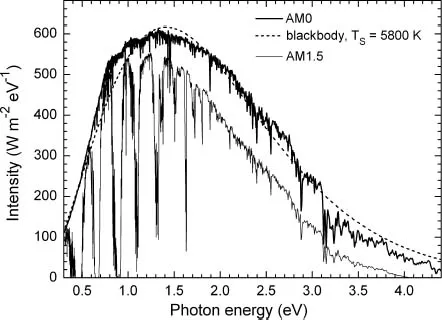
- 568 pages
- English
- ePUB (mobile friendly)
- Available on iOS & Android
Materials Concepts for Solar Cells
About this book
-->
A modern challenge is for solar cell materials to enable the highest solar energy conversion efficiencies, at costs as low as possible, and at an energy balance as sustainable as necessary in the future. This textbook explains the principles, concepts and materials used in solar cells. It combines basic knowledge about solar cells and the demanded criteria for the materials with a comprehensive introduction into each of the four classes of materials for solar cells, i.e. solar cells based on crystalline silicon, epitaxial layer systems of III-V semiconductors, thin-film absorbers on foreign substrates, and nano-composite absorbers. In this sense, it bridges a gap between basic literature on the physics of solar cells and books specialized on certain types of solar cells.
The last five years had several breakthroughs in photovoltaics and in the research on solar cells and solar cell materials. We consider them in this second edition. For example, the high potential of crystalline silicon with charge-selective hetero-junctions and alkaline treatments of thin-film absorbers, based on chalcopyrite, enabled new records. Research activities were boosted by the class of hybrid organic-inorganic metal halide perovskites, a promising newcomer in the field.
This is essential reading for students interested in solar cells and materials for solar cells. It encourages students to solve tasks at the end of each chapter. It has been well applied for postgraduate students with background in materials science, engineering, chemistry or physics.
--> Contents:
- Preface
- Symbols and Abbrevations
- Basics of Solar Cells and Materials Demands:
- Basic Characteristics and Characterization of Solar Cells
- Photocurrent Generation and the Origin of Photovoltage
- Influence of Recombination on the Minimum Lifetime
- Charge Separation Across pn -Junctions
- Ohmic Contacts for Solar Cells
- Maximum Efficiency of Solar Cells
- Materials Specific Concepts:
- Solar Cells Based on Crystalline Si
- Solar Cells Based on III–V Semiconductors
- Thin-Film Solar Cells
- Nano-Composite Solar Cells
- Solutions to Tasks
- Bibliography
- Index
-->
--> Readership: Advanced undergraduates and graduate students in photovoltaics, as well as students with background in materials science, engineering, chemistry or physics. -->
Keywords:Solar Cells;Solar Cell Materials;Photovoltaics;Absorber;Ohmic Contact;Silicon;GaAs;III–V Semiconductors;Thin-Film Solar Cells;Nano-Composite Solar Cells;Organic Solar CellsReview:
Reviews of the First Edition:
"The book offers a well-balanced treatment of physical principles and materials-related concepts of solar cells, and considers both classical and new trends in this rapidly developing field... The book is perfectly structured, with a concise summary of the most important points provided for every chapter, and the description of the concepts well complemented by the tasks. I strongly recommend this book for students and scientists attracted to the renewable energy and the materials science fields."
Andrey Rogach
Chair Professor of Photonic Materials
City University of Hong Kong
“The book is of good pedagogical value. Students as well as teachers can make use of this either as a main textbook or as a support for their lessons. In general, the book is well-written and provides a solid basis for studying solar cells.”
MRS Bulletin
0
Frequently asked questions
- Essential is ideal for learners and professionals who enjoy exploring a wide range of subjects. Access the Essential Library with 800,000+ trusted titles and best-sellers across business, personal growth, and the humanities. Includes unlimited reading time and Standard Read Aloud voice.
- Complete: Perfect for advanced learners and researchers needing full, unrestricted access. Unlock 1.4M+ books across hundreds of subjects, including academic and specialized titles. The Complete Plan also includes advanced features like Premium Read Aloud and Research Assistant.
Please note we cannot support devices running on iOS 13 and Android 7 or earlier. Learn more about using the app.
Information
1
Basic Characteristics and Characterization of Solar Cells
1.1Solar Radiation and Two Fundamental Functions of a Solar Cell











Table of contents
- Cover
- Halftitle
- Title
- Copyright
- Contents
- Symbols and Abbreviations
- Part I. Basics of Solar Cells and Materials Demands
- Part II. Materials Specific Concepts
- Appendix. Solutions to Tasks
- Bibliography
- Index